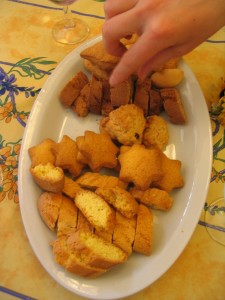 Our decision to include a culture and food component to the basic italian language training has proven to be a great choice. In addition to 3-4 hours of daily language instruction, Sooney and I are really trying to walk daily and now and then join group activities with the other 6 students for Institute-led excursions that have introduced us to the culinary delights of the Casentino region of Tuscany. And delights they are!
Our decision to include a culture and food component to the basic italian language training has proven to be a great choice. In addition to 3-4 hours of daily language instruction, Sooney and I are really trying to walk daily and now and then join group activities with the other 6 students for Institute-led excursions that have introduced us to the culinary delights of the Casentino region of Tuscany. And delights they are!
The staff of C.C.I.C Poppi (Centro Di Cultura Italiana Casentino) is extremely knowledgable in local lore, and have provided us with quite an introduction to this historical valley. Yesterday, Sooney and I walked 3 Km. to nearby Buiano (a local village of 8 dwellings) with instructions from our teacher who to contact for the key to the ancient “Roman” chapel of Santa Maria. We’re talking about “Una Pieve” that is recorded historically from the 11th century. The opportunity to practice our language with a kind, old gentleman was an added bonus as he guided us into the crypt and showed us Etruscan ruins among the original roman columns.
We parlayed that knowledge of early Roman archetecture today when our group visited a local town (Pratovecchio) that prides itself on its beautiful Roman’styled “La Pieve di Santa Maria Assunta” decorated with truly ancient gem: a “Virgine col Bambino” attributed to the Giotto (1290-1300) school, and a gorgeous terracotta relief of the “Madonna col Bambino” (Della Robbia 1437-1528) that smiled down upon us.
Our lunch, however, was the quintessential event! (I’m sensing a recurring theme here). Agri-Ttursimo is a concept whereby rural folks open their homes to travelers and feed them with local fare. Our little caravan wound its way into thte hills above Pratovecchio to “Agriresidence Valagnesi” and left about 3-hours later. Our meal started with (1) locally’made cheeses and cold cuts (ALL of which were made on’site), followed by (2) granno con pepperoni / gorgonzola (much like barley and the consistency of rissoto), (3) tortelli (tiny ravioli stuffed with potato) in a butter / sage sauce, (4) involtini (rolled) di tacchino (turkey) “ripiene” (stuffed) con fritatana / crema, (5) un tortino (similar to a quiche without the crust) consisting of one layer of mashed potatoes (a little milk, a couple eggs, butter, salt / pepper), mozzarella, stracchino cheese, another layer of the potatoe mixture, and topped with parmesean cheese and baked in the oven, served with (6) scallopini con funghi “prungnoli.”
All this was, of course, washed down with a delicious Tuscan red, and “digested” with home’made “Vinsanto” (a desert wine very similar to port made from extremely mature — and sweet — grapes) and, for the adventuresome, Sanbucco, and a variety of grappe. This feast was topped off with platefull of 6 diffrent kinds of biscotti (the one with hazelnuts was especially good with the vinsanto).
Of course, we’re showing moderation in our portions, and this eating elaborate meals out is clearly a luxury. We three (including our housemate Debbie from Los Gatos, CA) continue to prepare our own breakfast and, if there’s room, a simple third meal in our cozy kitchen. We’ve also “connected” with a lneighbor’s family garden and have access to locally-grown greens. These “cultural” events (read: Tuscan banquets) are, however, a lovely way to reinforce language instruction, wouldn’t you agree?
Ciao (burp),
Nicola
